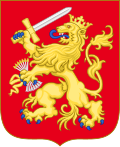Official symbols
Flag

Coat of arms

Dutch Republic Lion
The Dutch Republic Lion originates from the House of Nassau's coat of arms. The sword and sheaf of arrows in the lion’s paws come from States General of the Republic of the United Provinces coat of arms. The seven arrows stand for the seven united provinces of the States-General [1] and also symbolise the power of cooperation. [2]
National Anthem
Other
The colour orange has long been associated with the Netherlands due to Willem van Orange.
Other things commonly associated with the Netherlands include tulips, clogs, Gouda cheese and windmills.